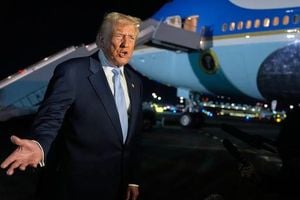The Smithsonian Institution, often called America’s attic, has found itself at the center of a storm after President Donald Trump ordered a sweeping internal review of its exhibitions and materials. The directive, issued on August 12, 2025, has ignited fierce debate about the role of museums in shaping national identity and the boundaries between history, politics, and culture. As the controversy unfolds, questions abound: Will the Smithsonian’s celebrated commitment to exploring the full sweep of American history—including its darkest chapters—survive this latest political intervention?
The spark for the uproar came when President Trump accused the Smithsonian of portraying U.S. history in an excessively negative light, focusing too much on the horrors of slavery and, in his words, being “OUT OF CONTROL.” According to The Nation, Trump’s letter to the Smithsonian demanded that its exhibits “reflect the unity, progress, and enduring values that define the American story.” The White House made clear that the goal was to shift the institution’s narrative away from what it sees as divisive or overly critical perspectives, and toward a vision of unity and progress.
Trump’s public statements left little doubt about his intentions. On August 21, 2025, he posted on Truth Social: “The Smithsonian is out of control, where everything discussed is how horrible our Country is, how bad Slavery was, and how unaccomplished the downtrodden have been. Nothing about Success, nothing about Brightness, nothing about the Future.” As WUSA9 reported, Trump went further, announcing that his attorneys would conduct a review of exhibits at several Smithsonian museums, including the widely acclaimed National Museum of African American History and Culture, the National Museum of American History, the National Museum of Natural History, the National Museum of the American Indian, the Smithsonian American Art Museum, the National Air and Space Museum, the National Portrait Gallery, and the Hirshhorn Museum and Sculpture Garden.
This move is hardly isolated. As The Times of India noted, it mirrors similar efforts by the Trump administration to reshape narratives in American universities, aiming to make national museums “less woke.” Critics argue that such interventions threaten to whitewash history and silence marginalized voices. “No one needs to make slavery sound worse than what it was for people to empathize with those people that experienced that awful institution and their descendants,” said Professor Niambi Carter of the University of Maryland, in comments to WUSA9. “They want all of the glory, but they don’t really want to claim any of the ugliness…I think Donald Trump is attempting to remove the parts of American history that makes him and other like him uncomfortable, but I think the message of any of these spaces is, your discomfort isn’t necessary. We should all be deeply impacted by these things and remember that we never do this again.”
The Smithsonian itself has not publicly commented on the president’s statements or the impending review. However, the institution’s recent history suggests the stakes are high. In 2016, the Smithsonian opened the National Museum of African American History and Culture, which quickly became one of the most visited museums in the country. Visitors have praised its comprehensive exploration of the Black American experience. “There is so much to see, it is amazing. I loved the depth and breadth that I saw,” said Kathleen Buschbacher, a visitor from Fairfax County. Another visitor, Alex from Texas, remarked, “I walked out there feeling uplifted, I walked out feeling inspired.”
This isn’t the first time American art and history have become battlegrounds for political and cultural conflict. The Nation drew a historical parallel to the 1946 “Advancing American Art” exhibition, which was organized by the State Department to showcase American paintings abroad. That show, featuring artists like Milton Avery, Romare Bearden, Georgia O’Keeffe, and Jacob Lawrence, encountered fierce opposition from conservatives who believed modern art was “Communistic” and failed to glorify the nation. Republican congressman George A. Dondero famously declared, “Modern art is Communistic because it is distorted and ugly, because it does not glorify our beautiful country and smiling people and our material progress. Art that does not glorify our country, in plain, simple terms, breeds dissatisfaction. It is therefore opposed to our government and those who create it and promote it are enemies.”
Ultimately, the State Department cut the tour short and sold off the artworks, but the episode did not end government support for modern art. During the Cold War, American modernism was promoted abroad as a symbol of freedom and self-invention, in stark contrast to the repressive cultural policies of the Soviet Union. President Dwight D. Eisenhower articulated the prevailing view: “As long as our artists are free to create with sincerity and conviction, there will be healthy controversy and progress in art. How different it is in tyranny. When artists are made the slaves and tools of the state; when artists become the chief propagandists of a cause, progress is arrested and creation and genius are destroyed.”
Today’s critics argue that Trump’s order risks repeating the mistakes of the past. “When you take away the context of an Emmitt Till or any of these other exhibits that are so powerful, I think we run risk of doing the same things again,” warned Professor Carter. She also expressed concern that this move comes at a time when Washington, D.C. is already experiencing heightened federal law enforcement presence and what some see as abuses of power. “This is happening at a time when D.C. is dealing with a great deal of federal law enforcement presence, and what some would say, an abuse power in some cases where we see people getting arrested and taken out of delivery trucks and other things. I think this move is even scarier.”
Meanwhile, the Smithsonian is looking to the future, planning two new museums: the National Museum of the American Latino and the American Women’s History Museum. Both are in the early stages of development, and it remains unclear whether these institutions will also be subject to the White House review.
For many, the Smithsonian’s current predicament is a cautionary tale about the enduring tension between art, history, and political power. As The Nation observed, “Art is inherently contentious, and its inevitable entwinement with politics contains unresolvable tensions.” The question now is whether the Smithsonian can continue to serve as a forum for honest reflection and debate about the American story—or whether it will be reshaped into a tool for promoting a sanitized vision of unity and progress.
Whatever the outcome, the debate over the Smithsonian’s future is far from over. The institution’s vast collections, celebrated exhibitions, and commitment to exploring the full range of American experience have made it a vital part of the nation’s cultural fabric. As the review unfolds, Americans—and the world—will be watching closely to see whether that legacy endures.




